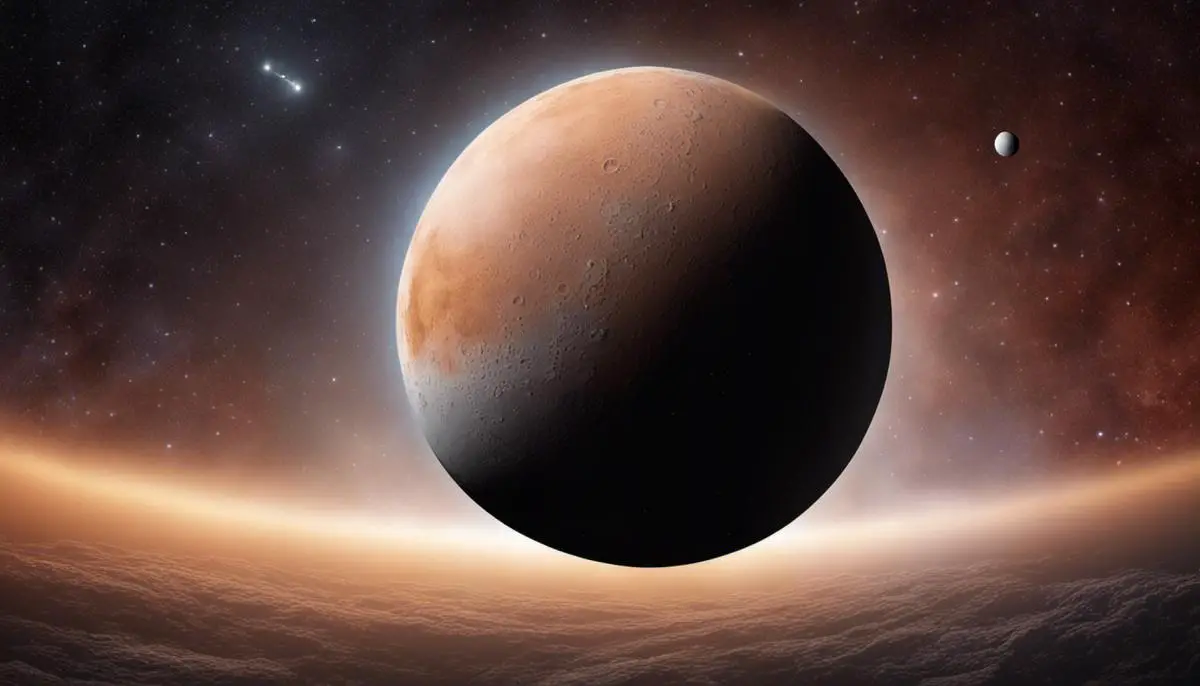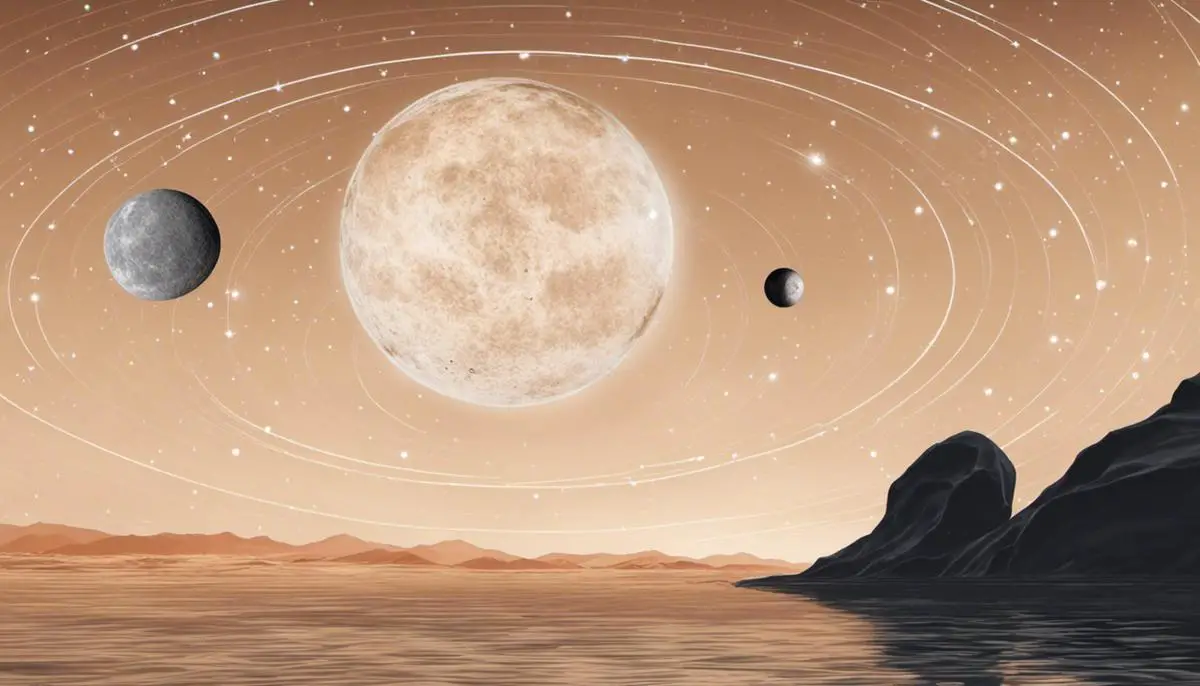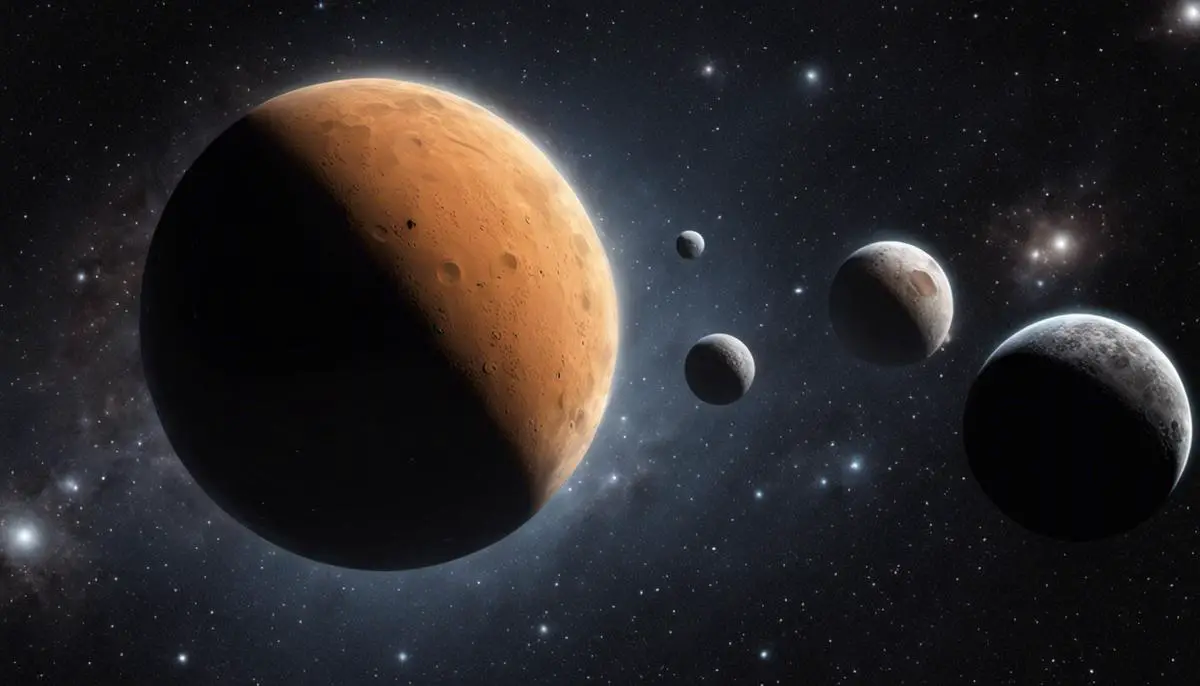The vast heavens offer an endless fascinate with celestial bodies that continue to astound us with their complex and unique natures. Of these, Sedna stands out as one of the most intriguing. Ranked among the most distant known objects in the Solar System, Sedna presents a unique case study in the field of astronomy. This mysterious, red-tinged world orbits our sun from the outermost reaches of our solar system, propelled by a journey that takes thousands of years to complete. With its rogue-like existance, Sedna sparks curiosity about its moons and their properties, providing scientific merits to examine with immense zeal.
Overview of Sedna
Overview: The Enigmatic Dwarf Planet Sedna
Sedna, officially designated 90377 Sedna, is a trans-Neptunian object or TNO, a group of celestial bodies that orbit the Sun beyond the planet Neptune. It is located in the far reaches of the solar system, specifically in the region known as the Inner Oort Cloud. This dwarf planet is one of the most remote bodies in the solar system, occupying an extremely elongated orbit that takes approximately 11,400 Earth years to complete.
Apart from its distinctive orbit, Sedna is known for its distinctive physical characteristics. It is a reddish object with a diameter estimated to be between 800 and 1,100 kilometers, making it slightly smaller than Pluto’s moon, Charon. Sedna’s red hue is believed to be due to organic material or tholin on its icy surface. Its surface is also unusually smooth, with few impact craters indicating a young and currently active surface.
Exploring the Possibility of Moons Around Sedna
At present, no moons have been identified in Sedna’s orbit. Nevertheless, the absence of discovered moons does not completely rule out the potential of Sedna possessing one or more moons. The presence of moons orbiting other trans-Neptunian objects, notably dwarf planets and even some asteroids, implies the plausible existence of moons surrounding Sedna. In order to confirm the presence of these celestial bodies, comprehensive exploration and improved high-definition imaging of Sedna are vital. Discovery of any moons around Sedna can yield crucial data about the circumstances prevailing in remote parts of our solar system, contributing a unique perspective towards our understanding of its formation and evolution.

Exploration and Discovery of Sedna’s Moons
The Detection of Sedna, A Distant Dwarf Planet
The dwarf planet known as Sedna was originally spotted by a group of astronomers, under the leadership of Michael Brown at Palomar Observatory in California, back in November 2003. The observation was made possible due to the utilisation of a Samuel Oschin telescope, fitted with a CCD camera capable of delivering high-definition images of the cosmos. After thorough scrutiny of these images, the astronomers identified a faint object tracing an extremely elliptical path, positioned well beyond the outer limits of our solar system. This distant celestial body was subsequently christened Sedna, named after the Inuit sea goddess.
Scrutinizing Sedna and its hypothesized moons
The immense interest in understanding and exploring Sedna and its potential moons has kept astronomers on their toes. Sedna, nestled in the farthest reaches of our solar system, the Oort Cloud, is a fascinating subject mainly due to its exceptionally elongated orbit. Understanding any potential moons that may accompany Sedna could shed light on the less explored areas of the universe, and possibly explain its unusual solar orbit.
Exploring Sedna and its potential moons is a daunting task, primarily due to its immense distance from Earth. To bridge this gap, ground-based telescopes like the Keck Observatory in Hawaii, and advanced space-based observatories such as the Hubble Space Telescope have been employed. Some scientists suggest that our understanding of Sedna and its moons may greatly benefit from future interstellar probes designed to breach our current limits of solar system exploration. Meanwhile, until our technology evolves further, the shadows hiding Sedna’s potential moons continue to persist.

Detailed Analysis of Sedna’s Moons
Deciphering the mysteries of Sedna’s putative moons
90377 Sedna, located in the distant fringes of our solar system, is a substantial minor planet that has sparked much interest and speculation. Despite our current advancements in observational astronomy, we have yet to corroborate the existence of any moons around Sedna. However, a blanket denouncement of their existence seems ill-advised. If they do orbit the minor planet, the nature of Sedna implies that its moons would exhibit unique orbital characteristics and physical properties – making them a truly captivating subject of study.
Orbital and Physical Properties of Hypothetical Sedna’s Moons
Information on the possible orbits of Sedna’s moons remains conjectural due to the extreme distance and observational challenges. However, if moons were present, they would likely exhibit a slow orbital period, similar to Sedna’s, which takes about 11,400 years to complete one orbit around the Sun. On an aspect of their physical properties, the nature and composition of these possible moons would likely be frozen and similar to other icy objects in the outer solar system. Likely, they would be highly influenced by the frigid temperatures of the outer solar system, possibly harboring methane ice and water ice surfaces, much like Sedna herself.
Exploring the Scientific Importance of Sedna’s Potential Moons
Within our knowledge of our solar system, Sedna’s theorized moons hold a compelling scientific interest. Specifically, these moons could contribute significantly to our understanding of the outermost peripheries of our solar system as well as the formation and evolution of icy celestial bodies. Their potential existence is not just significant in understanding comets and icy moons but is also thought to be crucial in understanding their interactions within the solar system. Additionally, their distinctive location could provide key information about the dynamics and conditions at the fringes of our system, providing invaluable data for comparative planetary studies. As such, the potential discovery and study of Sedna’s moons could facilitate groundbreaking developments in astronomical study.

Unresolved Mysteries and Future Research
Digging Deeper Into The Enigmas of Sedna and its Speculated Moons
As an object situated in the furthest reaches of our solar system, the dwarf planet Sedna, named after the Inuit goddess of the sea, remains a subject of riveting curiosity for astronomers. With its outstandingly distant and elongated orbit, Sedna takes a staggering 11,400 years to make a single revolution around the Sun. Among the numerous unresolved mysteries about Sedna is the question of whether it has any moons. Despite the advancements in telescopic technology, scientists have yet to determine definitively if Sedna does have any satellite bodies orbiting it. The investigation continues, as the existence of moons often provide critical clues about the history, composition and behaviour of their parent body.
Future Research and Exploration
There are currently no official missions planned for Sedna in the near future, primarily due to its extreme distance and orbit. However, with advancements in technology and deep-space exploration, Sedna continues to pique the interest of scientists world over. NASA’s New Horizons mission, which explored Pluto and the Kuiper Belt, has revolutionized our understanding of these distant worlds, and may pave the way to future missions aimed at Sedna. Such future space missions would be designed to confirm the presence of Sedna’s moons, explore its structure and composition, and potential signs of cryovolcanism. Breakthroughs are expected to deepen our understanding of the outer limits of our solar system and the formation of planets and moons.

Despite the distance and the mysteries shrouding Sedna and its moons, humanity continues to strive to unveil the secrets it holds. There are currently unresolved questions about Sedna’s moons that have puzzled scientists for decades, and it is these questions that drive our relentless pursuit for knowledge and understanding. Future missions and research projects aimed at Sedna promise to crack open these enigmas, shining a torch on the dark edges of our Solar System. As we anticipate these breakthroughs, Sedna, along with its moons, remains a silent sentinel, a floating marvel in the cosmos, challenging us to deepen our scientific understanding and push the boundaries of exploration.
![]()
